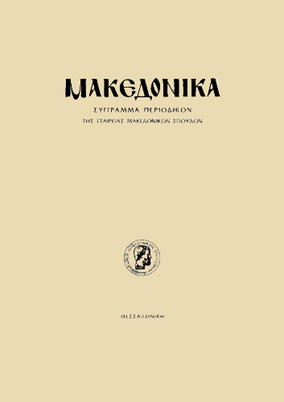Νέα στοιχεία για τη δραστηριότητα των ζωγράφων από το Λινοτόπι στην Ιερά Μονή Τιμίου Προδρόμου Σερρών
Part of : Μακεδονικά ; Vol.34, 2004, pages 331-357
Issue:
Pages:
331-357
Parallel Title:
New Elements for the Artistic Activity of the Painters from Linotopi in the Monastery of Timiou Prodromou in Serres
Section Title:
Articles
Author:
Abstract:
Researches of last decade on the wall paintings of earlier zone (1630) of southern colonnade -known as Makrinariki-in Katholikon and those of Parek- klision of Synaxes of Taxiarchon ( 1-643) in the Monastery of Prodromou in Serres, have led to the point of view that the Linotopi painters were present in this historical Monastery of Northern Greece. Linotopi was the first of the vil lages in which the artists have been specialized in various sections of artistic production (painting, wood-carving, metalwork) for professional reasons and it belonged in the group of villages called Vlachochoria of the Mountain Gram- mos and it had already been destroyed and ruined at the end of eighteenth century. With the help of recent bibliography and mainly of edited works which make the public aware of the orthodox monuments of Northern Epirus, the paintings of seventeenth century in the Monastery of Prodromou in Serres, have been attributed to the active and famous painters from Linotopi. Moreover, apart from the close relationship of painting with those of the monument Agios Nikolaos, Vitsa in Zagori (1618) and Agios Menas in Mono- dendri (1618/19) and others in Greece, it could be noted that there are many stylistic similarities with the paintings groups of Northern Greece, like: the paintings from the Monastery of Profitis Elias in Georgoutsati, Monastery of Koimesis of Theotokos in Vanista, Dropoli (1617), Monastery Metamorfosis of Sotera in Tsatista Pogoniou (1626), of Agiou Nikolaou in Sarakinista Liountzis (1630) and Monastery of Spilaiou (Cave) in Tranosista Liountzis (1631). Furthermore, it should be noted that the iconostasis doors from the templon of Parekklision of Taxiarchon, so as the despotic icon depicted the Archangels Michael and Gabriel dated in seventeenth century, could be pos sibly attributed to the activity of the same painters or to a related workshop. The point of view as mentioned above is empowered by the fact that the painters were called to decorate not only the church with wall paintings but also the templon with significant portable icons. That was a tactic which is established mainly in post-Byzantine era. Two icons of seventeenth century from the Ecclesiastical Museum in Serres depicted the Koimesis of Theotokos and the Theotokos holding the Child from the Monastery of Prodromou in Serres, have been attributed either to the same painter from Linotopi either to a painting workshop given the fact that there are stylistic similarities between them.The great founder of Monastery of Prodromou, the Monk Akakios who covered all the expenses of construction and mural decoration of the Parek- klision of Synaxes of Taxiarchon, he also ordered the decoration of two icons from Ecclesiastical Museum and the templon of the Parekklision, mentioned above, to the same painters from Linotopi. In conclusion, it should be noted that the presence and artistic activity of the painters from Linotopi were remarkable and significant in the area of that historical monument, the Monastery of Timiou Prodromou in Serres.
Notes:
856:https://ejournals.epublishing.ekt.gr/index.php/makedonika/article/view/6433, DOI: https://doi.org/10.12681/makedonika.878
Electronic Resources:




